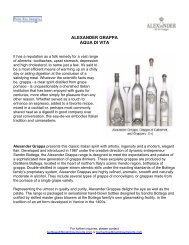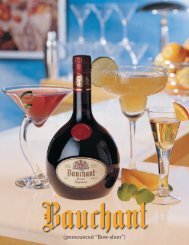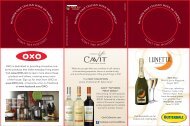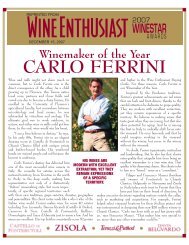You also want an ePaper? Increase the reach of your titles
YUMPU automatically turns print PDFs into web optimized ePapers that Google loves.
Standing<br />
tall<br />
Using his outsized<br />
personality, David Taub has<br />
built <strong>Palm</strong> <strong>Bay</strong> <strong>International</strong><br />
into one of the country’s<br />
leading wine importers<br />
by Mitch Frank<br />
David Taub dominates most rooms he<br />
walks into. At a recent gathering of wine<br />
and spirits industry executives in New<br />
York, it was easy to find the CEO of wine<br />
importer <strong>Palm</strong> <strong>Bay</strong> <strong>International</strong> as he<br />
moved through the crowd. Wherever<br />
there was laughter and energy, Taub<br />
stood in the center.<br />
It’s not because of his size. Taub stands 5 feet<br />
6 inches. But imposing height is not a prerequisite<br />
for vision. Over the past 33 years, Taub<br />
has built one of the country’s most successful<br />
import operations.<br />
<strong>Palm</strong> <strong>Bay</strong> started operations in 1977 by importing<br />
an obscure white wine from an unknown win-<br />
David Taub, CEO of <strong>Palm</strong> <strong>Bay</strong> <strong>International</strong><br />
Aug. 31, 2010 • Wine Spectator 73
Peaks tower over the Cavit Vineyards at Casa Toblino in the Trentino region of Italy. David Taub first visited Trentino in 1977 in search of a white wine to compete with the trendy Soave.<br />
ery in Trentino, a region many Americans didn’t realize was in Italy.<br />
The winery was called Cavit, and Taub’s aggressive marketing helped<br />
put Pinot Grigio on the map in the United States. Within five years,<br />
<strong>Palm</strong> <strong>Bay</strong> was importing 500,000 cases of wine annually. Last year,<br />
the company’s portfolio represented more than 5 million cases. While<br />
some labels are volume brands like Cavit, others are prestige producers,<br />
such as Planeta in Sicily and Fonterutoli in Tuscany.<br />
Part of Taub’s success lies in his strategy—he finds good producers<br />
and gives them the marketing and sales ammunition they need<br />
in the American marketplace. Part of it lies in the team he surrounds<br />
himself with.<br />
But a large part of <strong>Palm</strong> <strong>Bay</strong> is Taub’s personality. At 70 years of<br />
age, he is still brimming with new ideas. He can be disorganized and<br />
scattered. But when he wants something, he works tirelessly to get<br />
it, occasionally smothering people with kindness. “He has the best<br />
sort of attention deficit disorder,” says one former employee.<br />
Marc Taub, David’s son and <strong>Palm</strong> <strong>Bay</strong>’s president and chief operating<br />
officer, remembers a day trip they took to Yankee Stadium<br />
for a baseball game when he was in junior high. “On the drive<br />
home, my dad asks me what I’m doing that night,” Marc recalls.<br />
“I said, ‘I don’t know, probably watching the Islanders play the<br />
Penguins in the playoffs.’ ” This was the early ’80s, when hockey’s<br />
New York Islanders won four consecutive Stanley Cups. “My father<br />
says to me, ‘You want to go to the game?’ ‘Well that would<br />
be tough,’ I replied. ‘It’s in Pittsburgh.’ Next thing I know, we’re<br />
turning into LaGuardia Airport.”<br />
They arrived late in the first period, and David convinced the<br />
will-call attendant to sell them a pair of unclaimed seats.<br />
“My father has always been like that—in business and life,” says<br />
Marc. “When he wants something, he just pushes forward. When<br />
people explain why it can’t be done, he just doesn’t hear them.”<br />
Taub was born into the wine and spirits business. His father,<br />
Martin, jumped into the industry three days after Prohibition<br />
ended. In December 1933, he and three brothers opened<br />
a rectifying spirits business in Jersey City, buying alcohol in<br />
bulk, redistilling it to a higher proof, adding flavorings or<br />
aging it in barrel, and then bottling and selling it. Martin<br />
handled sales. Their best brand was Lafayette Brandy.<br />
During World War II, however, American distilleries were ordered<br />
to only produce industrial alcohol for the War Department,<br />
and large Canadian companies took over the spirits market. When<br />
the war ended, the Taub brothers found that demand for their<br />
brands had dried up. They struggled on for six more years before<br />
closing shop. Martin was looking for a new job when he was contacted<br />
by one of his old suppliers, a California winery owned by<br />
two brothers who used to sell him unaged brandy for $3 a barrel.<br />
Ernest and Julio Gallo needed a new distributor on the East Coast<br />
previous page: Marianne Rafter; this page: Matthew molchen<br />
74 Wine Spectator • Aug. 31, 2010
Matthew molchen<br />
and knew Martin was a good salesman.<br />
In 1952, with Gallo in his portfolio,<br />
Taub started Premier Wine &<br />
Spirits in New York City.<br />
David grew up knowing he’d work<br />
for his father, but after he started at<br />
Premier, he realized that his passion<br />
lay in wine imports. “That was the<br />
part of the business that I truly<br />
loved,” says Taub. Imports fit Taub’s<br />
personality. While Martin enjoyed<br />
the logistics of distribution, David<br />
enjoyed finding wineries, developing<br />
relationships with them and promoting<br />
their products.<br />
With Premier, Martin dabbled in<br />
importing in the ’60s, sold the import<br />
division for a profit in 1971, and then<br />
reentered the field by establishing<br />
<strong>Palm</strong> <strong>Bay</strong> in 1977. “At that time, we<br />
felt there were opportunities,” says<br />
David. “Something was happening<br />
in the Italian wine business that we<br />
found interesting.”<br />
What was interesting was that<br />
America was discovering Italian<br />
wine—easy-drinking Lambrusco,<br />
Valpolicella and a white wine from<br />
the Veneto called Soave. The Bolla<br />
family, based outside Verona, was exporting<br />
a large amount of Soave to<br />
the United States every year.<br />
Taub didn’t quite get the Soave<br />
phenomenon. He understood that it<br />
was fresh and exotic, but he thought<br />
it was a poor fit for American tastes.<br />
It was fruity up front, but he believed<br />
the almond note on the finish was<br />
rather bitter for a population that<br />
still drank more soft drinks than wine. So he asked some contacts<br />
to start scouring Italy for a fruity and fresh white wine. They put<br />
him in touch with a producer in a region even more obscure than<br />
Soave, where a third of the population spoke a German dialect.<br />
Trentino is a picturesque mountain province dominated by the<br />
southern reaches of the Alps and the Dolomites. Valleys wind their<br />
way past the peaks to intersect in the Adige river valley and its<br />
main city of Trento. The region has only been part of Italy since<br />
1919. For the century before that it belonged to Austria, and for<br />
800 years it had been an independent province, governed by the<br />
local Bishop of Trento.<br />
That independent streak continues to this day. The local cuisine<br />
and architecture blend Austrian and Italian influences. And for<br />
more than a century, vineyard owners have planted a large variety<br />
of grapes, including local types such as Lagrein, Schiava, Marzemino<br />
and Teroldego, as well as international varieties such as Chardonnay,<br />
Pinot Grigio, Cabernet and Merlot.<br />
Like many areas of Italy, Trentino found itself losing farmers to<br />
The Cavit winemaking team, from left: winemaker Andrea Faustini, chief winemaker Anselmo Martini, winemaker Guido Mattiello,<br />
winemaker/agronomist Fabrizio Marinconz, sparkling wine maker Paolo Turra. The co-op includes 11 wineries and 5,000 growers.<br />
“When my father wants<br />
something, he just pushes<br />
forward. When people<br />
explain why it can’t be done,<br />
he just doesn’t hear them.”<br />
—MArc taub<br />
the cities after World War II. Local vineyard owners,<br />
many of whom farmed multiple crops and owned just<br />
an acre or two of vines, formed a cooperative in 1950<br />
to pool resources. They named their winery the Cantina<br />
Viticoltori del Trentino, Ca’Vit for short.<br />
Taub arrived in Trento in June 1977. “I thought I<br />
was Alice in Wonderland. This was such a gorgeous<br />
part of Italy. I could not believe I had been to Italy<br />
many times and had never seen it.”<br />
He wanted to push ahead at top speed. Luckily for<br />
him, Ca’Vit was eager to explore the U.S. market and<br />
was willing to follow <strong>Palm</strong> <strong>Bay</strong>’s guidance. In return, Taub promised<br />
that it would be Ca’Vit’s name on the bottle—even if the partnership<br />
didn’t work, the co-op would still own the brand. “The key<br />
was that we were going to build Ca’Vit,” he says. “We weren’t just<br />
treating them as a supplier selling us juice for a private label.” Taub<br />
did request one change—ditch the apostrophe and change the<br />
name to Cavit. In September, the co-op sent a few hundred cases<br />
of a brand named Principato by Cavit to the United States.<br />
<strong>Palm</strong> <strong>Bay</strong>’s plan was to focus on white wines that could compete<br />
with Soave. Taub believed Pinot Grigio, in particular, held<br />
promise. “We felt like Pinot Grigio was more in the American<br />
style—easy to drink, customer-friendly,” he says. “The problem<br />
was, how do you take a wine that no one had heard of and introduce<br />
it into the marketplace?”<br />
Taub is still proud of his early efforts. A full-page ad in The New<br />
York Times asked, “Is your Soave really suave?” And in radio and<br />
print ads, popular talk show host Dick Cavett explained that Cavit<br />
was pronounced like his last name. “I’m the Cavett from Nebraska,<br />
Aug. 31, 2010 • Wine Spectator 77
Cavit is the wine from the Italian Alps.” The Taubs’ history in distributing<br />
gave Cavit access to most major American markets. And<br />
soon enough, Americans did fall in love with Pinot Grigio. Italian<br />
acreage of the varietal doubled between 1990 and 2000. Cavit<br />
wasn’t the only Italian brand behind the trend—Taub still views<br />
Santa Margherita as his chief rival—but within two years of its<br />
launch, <strong>Palm</strong> <strong>Bay</strong> had imported 500,000 cases of Cavit wines.<br />
Today, it’s 3 million cases a year. A full 75 percent of Cavit’s<br />
wine comes to the United states. The scale of<br />
the operation required to produce that much<br />
wine is impressive; the only efficient way to see<br />
Cavit’s vineyards is via helicopter. On a bright<br />
spring day, Cavit executives do exactly that,<br />
taking Taub and other guests on a tour over the<br />
Adige and neighboring valleys. As far as the eye can<br />
see, from one side of the valley floor to the other,<br />
there are vines, jostling for space with Trentino’s other<br />
top resource, apple trees.<br />
Cavit is composed of 11 member wineries and almost<br />
5,000 growers, who farm 17,000 acres. Most of<br />
those growers cultivate old family vineyards of 1 to 2<br />
acres and have day jobs outside the wine industry.<br />
Selling to Cavit lets them keep their family plots; in<br />
return, the co-op provides plenty of technical support.<br />
Cavit guarantees quality by having member<br />
growers agree to a lengthy set of rules. It also requires<br />
that they sell their entire crop to the co-op; a grower<br />
can’t keep the best grapes for his own label and sell<br />
the lesser fruit to Cavit.<br />
Back on the ground, the Cavit execs give a tour of<br />
their main facility, located just uphill from the center<br />
of downtown Trento. Led by head enologist Anselmo<br />
Martini, they show off several vinification cellars, including<br />
a large sparkling wine facility and a semiautomated<br />
cellar built in 2000 that is full of 150,000-gallon<br />
tanks for fermentation and 800,000-gallon tanks<br />
for blending, all operated by two men in a small office.<br />
And this is just one of a dozen facilities in the<br />
valley. Nearly two-thirds of the wine made in Trentino<br />
has Cavit’s label on it. In 2006, the company had<br />
sales of almost $250 million, making it the third biggest<br />
wine company in Italy.<br />
After the tour, the group heads for lunch at Maso<br />
Toresella, a medieval villa on the shore of Lake<br />
Toblino that was once home of the ruling Bishop of Trento. The<br />
current president of the co-op, Adriano Orsi, greets Taub at the<br />
front door. They talk back and forth for five minutes, despite the<br />
fact that Taub speaks little Italian and Orsi knows almost no English.<br />
<strong>Palm</strong> <strong>Bay</strong> Vice President Michael Petteruti, who’s been with<br />
Taub for 37 years and acts as translator on most of these trips, labors<br />
to keep up as Taub speaks a mile a minute. But it’s no matter—through<br />
his hands, facial expressions and sheer enthusiasm,<br />
Taub manages to get across most of what he’s saying. This scene<br />
is repeated throughout the day—Taub doesn’t need to speak Italian,<br />
he communicates by force of will.<br />
Over lunch, the Cavit team explains how the relationship with<br />
<strong>Palm</strong> <strong>Bay</strong> evolved. Martini and former director general Giacinto<br />
Giacomini worked with Taub constantly. Cavit’s scale, combined<br />
with the large array of grape varieties grown in the region, has allowed<br />
Taub to go back to them repeatedly over the past three decades<br />
to source new wines to sell based on U.S. market trends. Over<br />
the years, they have experimented with many varietals. Taub loved<br />
the obscure local red grape called Teroldego, but it never took off.<br />
<strong>Palm</strong> <strong>Bay</strong> imported a “Rhine Riesling” in 1982 that failed, but began<br />
selling Riesling again a few years ago to more success. Pinot<br />
Filippo (left) and Francesco Mazzei of Castello Fonterutoli have partnered with <strong>Palm</strong> <strong>Bay</strong> for several years now.<br />
“<strong>Palm</strong> <strong>Bay</strong> is a dynamic<br />
family business, understanding<br />
of Italian culture<br />
and willing to establish<br />
long-term relationships.”<br />
—Filippo mazzei<br />
Noir was a flop in 1984, but has been<br />
a best seller since 1998.<br />
<strong>Palm</strong> <strong>Bay</strong> has also provided Cavit<br />
with other business. When Gallo<br />
was starting the Italian label Ecco<br />
Domani in the ’90s, Taub helped<br />
Cavit become the supplier for several<br />
years. And, as export manager<br />
Massimiliano Giacomini explains,<br />
for almost a decade now, the old<br />
Principato brand has been the<br />
house wine “for a little Italian restaurant you may have heard<br />
of—Olive Garden.”<br />
Olive Garden sells more wine than any other restaurant chain<br />
in America—more than half a million cases a year. And the<br />
chain’s management, Darden restaurant group, sees educating<br />
average diners about wine as part of its core strategy. The director<br />
of beverage services told a group of journalists in 2005, “We<br />
want to do for wine what Starbucks did for coffee. Before Starbucks<br />
went nationwide, few people had ever heard of a latte, and<br />
now it’s part of the language. We’d be happy if we could encourage<br />
people to become equally knowledgeable about wine.”<br />
In 1998, Olive Garden partnered with <strong>Palm</strong> <strong>Bay</strong>, designating<br />
stefano amantini/atlantide<br />
78 Wine Spectator • Aug. 31, 2010
marianne rafter<br />
Principato as its house wine. It also approached Taub<br />
about a possible project, hoping to add to the authenticity<br />
of its cuisine and atmosphere. A year later, the restaurant<br />
chain opened the Olive Garden Culinary Institute<br />
in Tuscany, where it sends groups of managers a few<br />
times a year to learn Italian cooking on the ground. The<br />
institute, located in an agriturismo just outside Castellina<br />
in Chianti, is run by one of <strong>Palm</strong> <strong>Bay</strong>’s producers, Rocca<br />
delle Macie. Interiors of the most-recently built Olive<br />
Gardens are modeled on the Castellina farmhouse where<br />
the school is located. Asked how much wine he sells<br />
through Olive Garden, Taub would only smile and say,<br />
“Very significant volume.”<br />
While Cavit provides <strong>Palm</strong> <strong>Bay</strong> with a reliable revenue<br />
stream, the importer has worked to acquire more upscale<br />
wines. Italy still dominates the 75-brand portfolio, but<br />
the company has diversified in the past decade to add<br />
wines from 10 other countries, including France, Spain,<br />
Australia and Chile.<br />
One former <strong>Palm</strong> <strong>Bay</strong> employee who now works for a<br />
rival says <strong>Palm</strong> <strong>Bay</strong> doesn’t usually find undiscovered regions<br />
or wines, but rather identifies the producer with the<br />
most potential in a region and puts sales and marketing<br />
muscle behind them, whether it’s Planeta in Sicily, Feudi<br />
di San Gregorio in Campania, Santa Rita in Chile or Recanati<br />
in Israel.<br />
For many of Taub’s clients, the relationships he builds<br />
are the chief draw. “For a family company like ours, we<br />
share common values and a long-term approach,” says<br />
Jean-Charles Cazes, whose family owns Bordeaux’s Château<br />
Lynch-Bages and eight other wineries in France,<br />
Portugal and Australia. <strong>Palm</strong> <strong>Bay</strong> imports all their wines,<br />
save Lynch-Bages, which is sold through the Place du<br />
Bordeaux. “If I should define David in one word, that<br />
would be ‘charismatic.’ He is a man of vision, and someone<br />
you can trust.”<br />
Filippo Mazzei, who co-manages his family’s Castello di<br />
Fonterutoli in Chianti, says, “<strong>Palm</strong> <strong>Bay</strong> is a dynamic family business,<br />
understanding of Italian culture and values, as well as willing<br />
to establish long-term relationships. David is a very intelligent and<br />
skilled person who usually gets to the point right away with a problem-solving<br />
approach.”<br />
It’s hard to imagine <strong>Palm</strong> <strong>Bay</strong> without Taub’s energy, but it’s not<br />
a one-man show. For six years now, son Marc has worked as COO.<br />
Marc was previously president of the distribution arm, Premier,<br />
but in 2004, the Taubs left the distributing business, selling Premier<br />
to Southern Wine & Spirits for an undisclosed sum. Southern<br />
was making an aggressive play to enter the New York market,<br />
and the wholesaler industry was in a consolidating phase. The<br />
Taubs felt it was time to sell. Both say they believe importing is a<br />
more dynamic, growing industry.<br />
They are also now venturing more into spirit imports. <strong>Palm</strong> <strong>Bay</strong><br />
recently started importing Aperol, an Italian aperitif that is a<br />
lighter, less-bitter version of Campari. In April, they hired Alain<br />
Barbet, former CEO of Pernod Ricard’s Americas division, to head<br />
a new spirits division, suggesting that more brands will soon be<br />
joining the portfolio.<br />
The business is in their blood: <strong>Palm</strong> <strong>Bay</strong> CEO David Taub (left), and his son Marc, COO and president,<br />
have worked for decades in the company founded by David’s father, the late Martin Taub (portrait).<br />
Walking around <strong>Palm</strong> <strong>Bay</strong>’s Long Island headquarters with<br />
Taub can be slow going. He stops almost every young<br />
staffer who passes in the hall to ask him or her a question<br />
or get an update on current projects. He sticks his<br />
head in about half the offices to do the same.<br />
When not working, Taub, with his wife, Linda, a retired<br />
attorney, is actively involved with several charities,<br />
particularly those focusing on cancer treatment. The couple has<br />
three sons and six grandchildren. Marc lives in Manhattan, while<br />
Andrew, the oldest, owns a recording studio in Brooklyn. Youngest<br />
son Joshua lives in the Los Angeles area, where he works as vice<br />
president of sales at Activision, the video game company behind<br />
“Guitar Hero.”<br />
Though he’s handed more responsibilities to Marc at this point,<br />
Taub is active in multiple projects, still feverishly working on fresh<br />
ideas. His eyes start dancing when he talks about a new wine from<br />
Puglia or a new trend in spirits. Taub is doing what he loves—discovering<br />
wines (and the people behind them) and trying to sell<br />
them. He still lights up a room. And he still casts a big shadow in<br />
his industry.<br />
Aug. 31, 2010 • Wine Spectator 79








